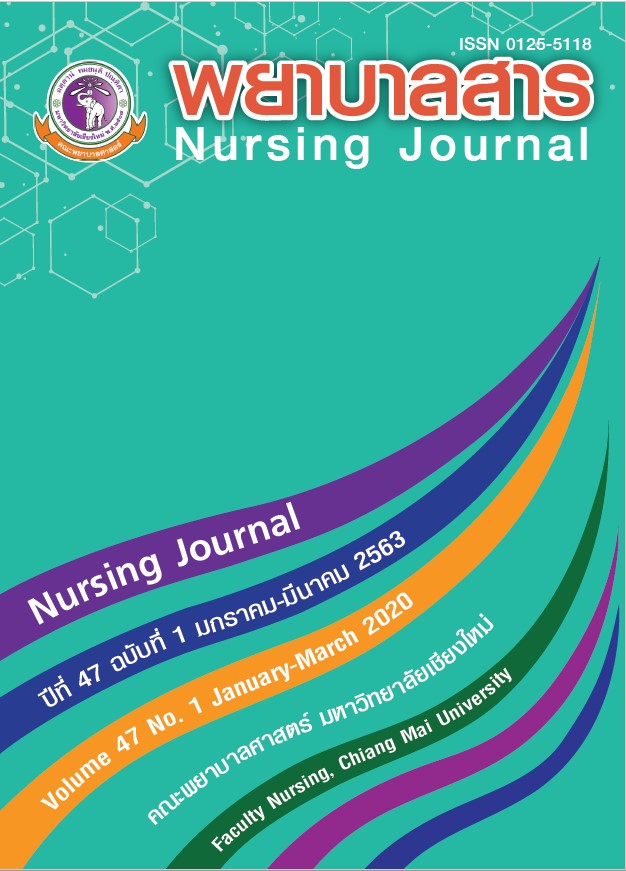Related Factors of Maternal Practices for Recurrent Pneumonia Prevention Among Children
Keywords:
maternal practices, recurrent pneumonia, Related FactorsAbstract
Recurrent pneumonia is still a common problem and prevalence is higher among children. Maternal Practice is the most effective way to prevent recurrent pneumonia. The purpose of this correlational descriptive study was to examine maternal practices and related factors for recurrent pneumonia prevention in children. The subjects of this study included mothers of children with pneumonia under the age of five years and admitted to the pediatrics unit at Nakornping Hospital, Chiangrai Prachanukroh Hospital, Lamphun Hospital and Lampang Hospital. Data were collected from March to May 2015. The study instruments were comprised of a maternal practices for recurrent pneumonia prevention in children questionnaire and a related factors of maternal practices for recurrent pneumonia prevention in children questionnaire, which recorded the perceived severity, perceived benefits, perceived barrier and perceived self-efficacy. The content validity of all questionnaires were confirmed to be valid by a panel of experts, scoring the values.84, .80, .88, .94 and .95 respectively. The reliability of the questionnaires was also tested. The Cronbach’s alpha coefficients of the questionnaire were 0.80, 0.80, 0.80, 0.81 and 0.92. Data were analyzed using descriptive statistics, the Pearson product moment correlation coefficient and the Spearman rank correlation coefficient.
The results of this study showed that:
- 1. Seventy-one point eight percent of the mothers had high levels of practice in recurrent pneumonia prevention.
- 2. There was a statistically significant positive correlation between perceived self-efficacy and maternal practices for recurrent pneumonia prevention in children (r = .233, p < .05).
This study provides an understanding of maternal practices and perceived self-efficacy for mothers to help prevent recurrent pneumonia in children. This information can be used as a guide to improve their maternal practices for recurrent pneumonia prevention in children.
References
Becker, M. H. (1974). The health belief model and sick role behavior. New Jersery: Chares B. Slack.
Bland, A. D., Kegler, M. C., Escoffery. C., & Malcoe, L. H. (2005). Understanding childhood lead poisoning preventive behavior: The roles of self-efficacy, subjective norms, and perceived benefits. Preventive Medicine, 41, 70-78
Bureau of Epidemiology of Department of Disease Control. (2013). Pneumonia. Retrieved from http//www.epid.moph.go.th/Fact/Pneumonia.htm (In Thai)
Chaidee, C., Santi, S., & Kongsaktrakul, C. (2012). Factors Related to Acute Respiratory Infection Prevention Behavior of Child Caregivers in Day Care Centers. Proceeding in the conference, The 2nd International Nursing Research Conference 2012. (In Thai)
Kaewsuk, C., Pongjaturawit, Y., & Chaimongkol, N. (2016). Factors Associated with Maternal Behavior in Prevention of Acute Respiratory Infection in Preschool Children. The Journal of Faculty of Nursing Burapha University, 24( 4), 54-64.
Hoving, M. F., & Brad, P. L. (2013). Causes of recurrent pneumonia in children in a general hospital. Journal of Paediatrics Child and Health, 49(3), 208-212. doi:10.1111/jpc.12114
Medical Service Department. (2013). Pneumonia Statistics in Children. Retrieved from http://www.msd.bangkok.go.th/healthconner_pneumonia.htm (In Thai)
Office of Policy and Strategy,Nakornping Hospital. (2014). Statistics of pneumonia in children under 5 years. Chiang Mai: Nakornping Hospital. (In Thai)
Plodnaimuang, A. (1999). The effectiveness of support and education programs to improve performance awareness in self-care and disease control in patients with type 2 diabetes who cannot control the disease. Bangkok: Mahidol University. (In Thai)
Polit, D. F. (2010). Statistics and data analysis for nursing research (2nd ed.). United State of America: Ewards Brothers.
Portmann, M. P., & Soto-Martínez, M. (2014). Recurrent lower respiratory tract infections in children. Retrieved from http://www.medicalobserver.com.au/news/recurrent-lower-respiratory-tract-infections-in-children
Rattanapitak, U. (1997). Effects of nursing system on behavioral support and support system Self-care towards diabetes control. Master thesis, Graduate School, Mahidol University. (In Thai)
Samit, J., Lamchang, S., & Mesukko, J. (2013). Informational support, self-efficacy and parent participation in caring for hospitalized children with acute illness. Nursing Journal, 40(4), 114-125. (In Thai)
Sinaniotis, C. A. (2005). Community-acquired pneumonia in children. Current Opinion in Pulmonary Medicine, 11(3), 218-225.
Somboonnak, J. (2004). The factors related to acute respiratory infection in children prevention and control behaviors in 0-5 years children’s mothers in Pramongkutkloa hospital. Master Thesis (Health Education). Kasetsart University. (In Thai)
Suphanjanaphop, O. (2000). Factors affecting parents' pneumonia prevention behaviors of children who are hospitalized. Under the Ministry of Public Health, Master of Science Thesis Health Education Program. Graduate School, Kasetsart University. (In Thai)
Suthiwirakachon, W. (2013). Recurrent / Persistent Pneumonia In Chitladda Derojanawong, Suchada Sriphipayawan, and Kanokporn Udomittiphong (Editor), guidelines for the care of common respiratory problems in children. Bangkok: Department of Pediatrics Faculty of Medicine Chulalongkorn University. (In Thai)
World Health Organization. (2012). Pneumonia in children. Retrieved from http://www.who.int/ mediacentre/factsheets/fs331/
World Health Organization. (2013). Pnuemonia. Retrieved from http://www.who.int/entity/ mediacentre/factsheets/fs331/en/
Yod-in, M. (2014). Factors Related to Maternal Behavior in Caring for Children with Acute Respiratory Infection (Master of Science Thesis Health Education Program). Graduate School, Srinakharinwirot University. (In Thai)
Downloads
Published
How to Cite
Issue
Section
License
บทความที่ได้รับการตีพิมพ์เป็นลิขสิทธิ์ของวารสารพยาบาลสาร
ข้อความที่ปรากฏในบทความแต่ละเรื่องในวารสารวิชาการเล่มนี้เป็นความคิดเห็นส่วนตัวของผู้เขียนแต่ละท่านไม่เกี่ยวข้องกับมหาวิทยาลัยเชียงใหม่ และคณาจารย์ท่านอื่นๆในมหาวิทยาลัยฯ แต่อย่างใด ความรับผิดชอบองค์ประกอบทั้งหมดของบทความแต่ละเรื่องเป็นของผู้เขียนแต่ละท่าน หากมีความผิดพลาดใด ๆ ผู้เขียนแต่ละท่านจะรับผิดชอบบทความของตนเองแต่ผู้เดียว






